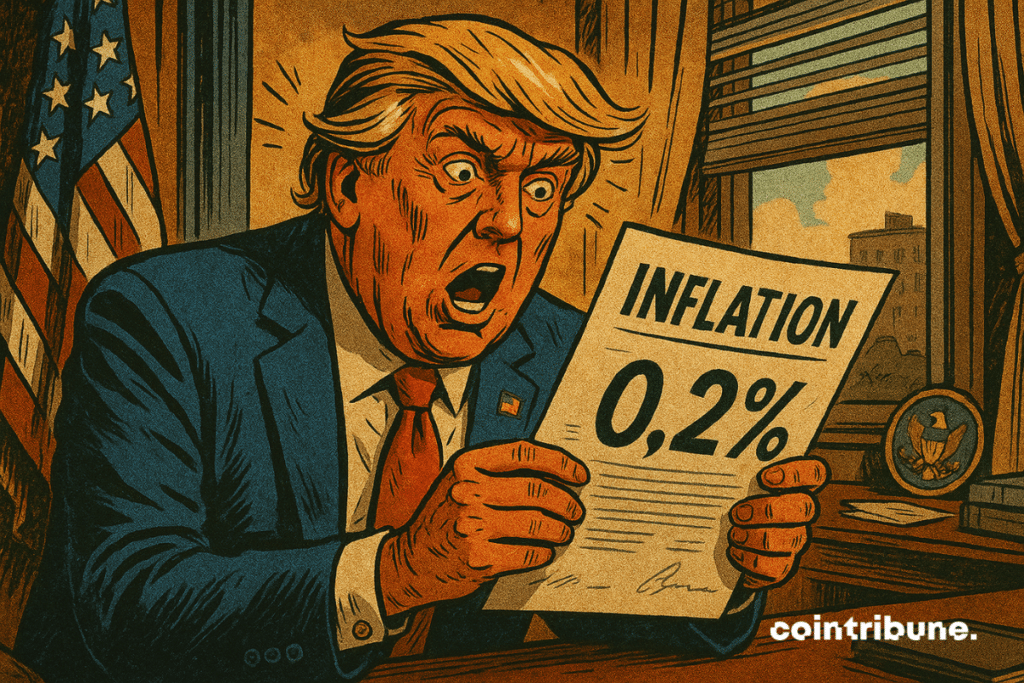Inflation Defies Trump’s Price Pressure—Here’s Why Markets Didn’t See It Coming
Defying political rhetoric and Wall Street’s doom-loop forecasts, inflation numbers just took an unexpected dive. The usual suspects—supply chains, labor costs, even crypto volatility—are suspiciously quiet. Meanwhile, the Fed’s playbook gathers dust while algorithms scramble to adjust.
Key drivers? Try energy deflation punching holes in CPI calculations and a consumer base that’s finally learned to bypass overpriced avocado toast. Even Washington’s tariff tantrums couldn’t keep the numbers elevated.
Of course, your portfolio manager will still find a way to charge 2% for ’navigating these uncertain times.’ Some things never deflate.

In brief
- Inflation fell to 2.3% in April from 2.4% in March, its lowest level since 2021.
- Trump’s tariffs have not yet produced the anticipated inflationary effect.
- Trade agreements with China and the UK could mitigate the impacts.
- Experts anticipate more pronounced effects in the coming months.
American inflation declines despite Trump tariffs
The U.S. Bureau of Labor Statistics released data on May 13 that embarrasses the doomsayers: American inflation slowed for the third consecutive month, falling from 2.4% in March to 2.3% in April.
This decrease marks the smallest increase since February 2021 and paradoxically brings the U.S. economy closer to the 2% target set by the Federal Reserve, precisely when everyone predicted otherwise.
The Consumer Price Index (CPI) ROSE only 0.2% in April compared to March, while economists, convinced of an immediate Trump effect, expected a 0.3% increase.
Even more surprisingly, the Core CPI, which excludes volatile components like food and energy, was also limited to a 0.2% increase, defying all predictions.
However, this lull conceals contrasting sectoral trends. Food prices fell by 0.1%, a first since 2020, while energy rebounded by 0.7% after a 2.4% drop the previous month. Housing, a major component of the CPI, maintained a stable annual increase of 4%.
Delayed but inevitable effects?
Faced with these embarrassing figures, analysts are looking for explanations to save their alarming forecasts.
In early April, the U.S. president had indeed set a benchmark rate of 10% on most imports, with duties of 145% on Chinese products and 25% on automobiles, steel, and aluminum.
BeiChen Lin, senior strategist at Russell Investments, tries to justify the discrepancy:
Businesses likely built up inventories before the tariffs took effect, delaying their impact on inflation.
A convenient excuse echoed by UBS, which now pushes its catastrophic predictions to between May and October.
In the meantime, trade negotiations are progressing. An agreement with China provides for a mutual reduction of tariffs by 115 points for 90 days, while an arrangement with the United Kingdom exempts certain strategic sectors, suggesting a more nuanced approach than the foretold apocalypse.
JPMorgan also sounded the alarm, raising the probability of a global recession to 60%. The bank estimates these protectionist measures will cost American consumers $700 billion, equivalent to 2.4% of GDP.
The American economy seems to resist the darkest predictions: inflation slowing against all odds and tariffs whose apocalyptic effects are still awaited.
This lull may only be temporary, leaving markets anticipating the next decisions of the Fed and the evolution of international trade negotiations. Only the coming months will reveal whether this resilience endures or if the delayed impacts finally materialize.
Maximize your Cointribune experience with our "Read to Earn" program! For every article you read, earn points and access exclusive rewards. Sign up now and start earning benefits.

